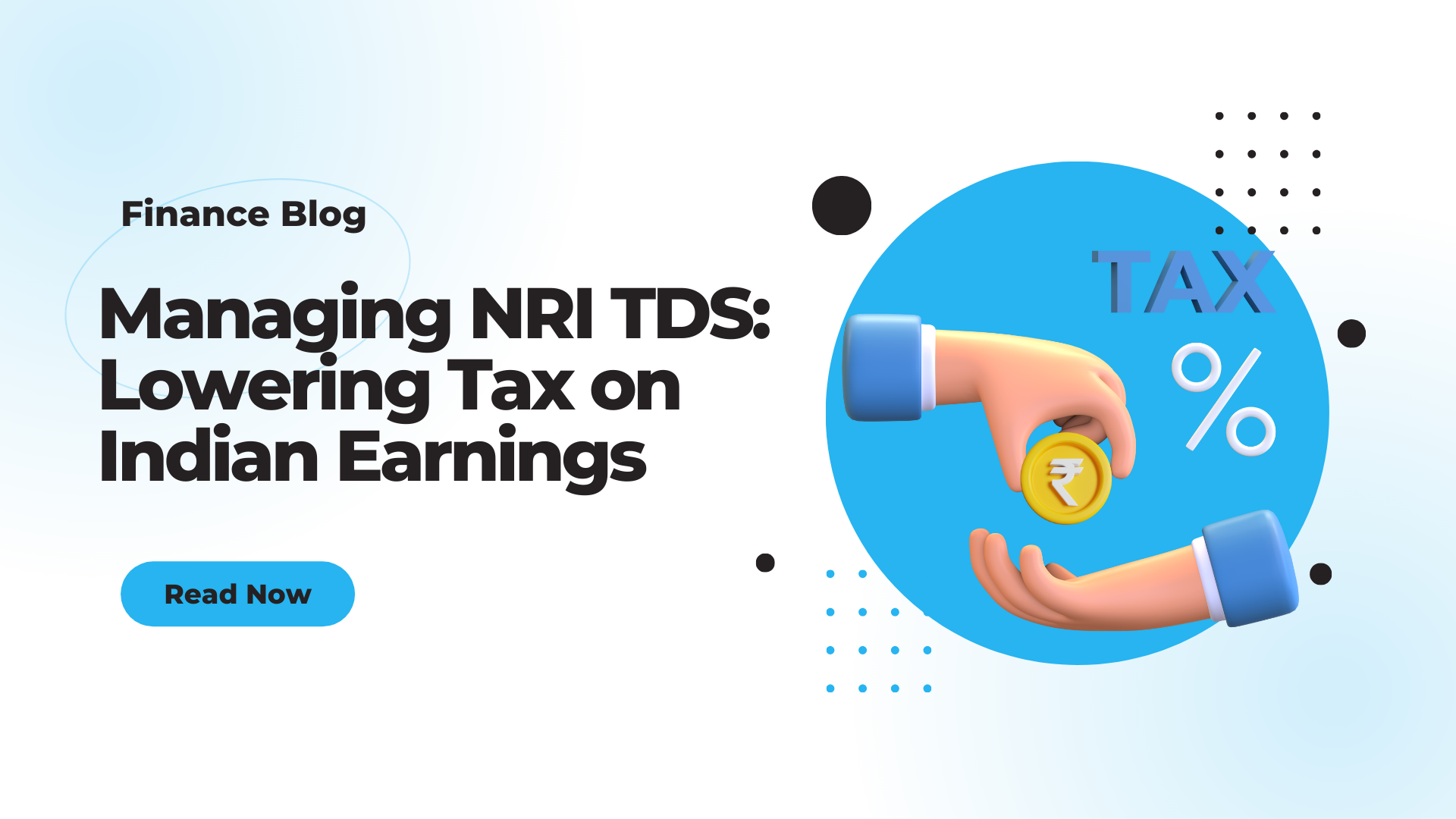Introduction
As a Non-Residential Indian (NRI), you may have diverse income sources from India that are subject to Tax Deducted at Source (TDS). Whether it’s from fixed deposits, rental income, or capital gains from investments, these income streams are subject to Tax Deducted at Source (TDS) – a means of collecting tax at the point of origin of income. While it’s a legal obligation, nobody likes to pay more tax than they need to. So, how can you, as an NRI, lower your TDS on income earned from India? In this article, we will explore the most practical strategies and insights to help you minimize your TDS obligations and optimize your financial returns.
NRI TDS in India
As a Non-Residential Indian (NRI), understanding the taxation system can be a bit complex, especially when it comes to Tax Deducted at Source (TDS). In India, TDS is a method of tax collection where a certain percentage of the payment is deducted at the source by the payer. This amount is then remitted to the government on behalf of the receiver, in this case, the NRI.
The application of TDS for NRIs is different from residents of India. This is mainly because the Income Tax Act, 1961, considers the residential status, type of income, and the transaction involved while deciding the rate and the applicability of TDS. Therefore, the income that an NRI earns in India is subject to TDS.
Types of income subjected to TDS for an NRI include:
- Interest earned on savings or fixed deposit bank accounts
- Rental income from property in India
- Capital gains from the sale of investments or property
- Income from bonds or securities
It’s crucial for NRIs to understand that the rate of TDS is usually higher for them compared to residents. However, various strategies can help an NRI lower their TDS liability, which we will discuss in further sections of this article.
Remember, while TDS is a useful tool to ensure tax compliance, it’s equally important to file your Income Tax Return (ITR) in India if your income exceeds the basic exemption limit. This is because TDS is only a part of your total income tax liability and if TDS deducted is more than your actual tax liability, you can claim the excess amount as a refund by filing your ITR.
What is Section 195?
Section 195 of the Income Tax Act, 1961 is a critical taxation provision that directly impacts NRIs. It lays down the rules for the deduction of tax at source (TDS) from payments made to non-residents.
This section specifically deals with any payment chargeable under the provisions of the Act to a non-resident or a foreign company. In essence, if an Indian entity makes any ‘chargeable’ payment to a non-resident, then it is required to deduct tax at source on such payments. The term ‘chargeable’ refers to any income chargeable under the Act, including salary, interest, dividend, royalties, technical service fees, etc.
The core of Section 195 is that any person responsible for paying to a non-resident (not being a company) or to a foreign company, any interest or any other sum chargeable under the provisions of this Act (not being income chargeable under the head “Salaries”) shall, at the time of credit of such income to the account of the payee or at the time of payment thereof in cash or by issue of a cheque or draft or by any other mode, whichever is earlier, deduct income-tax thereon at the rates in force.
Note: The provision of TDS under section 195 does not apply to salaries, which are governed by a different set of rules under the Act.
Section 195 is particularly important for NRIs as it determines their tax liability on income generated in India, and thus any strategies for lowering TDS for NRIs needs to take this section into account.
1. The Scope of TDS for NRIs
As a Non-Residential Indian (NRI), you may find yourself within the purview of the Indian taxation system, specifically regarding Tax Deducted at Source (TDS), particularly if you generate income from sources within India. The scope of TDS for NRIs covers various forms of income, which include, but are not limited to:
- Interest earned on bank deposits
- Dividends from shares of Indian companies
- Income from property transactions
- Royalty or fees for technical services
- Incomes from other sources that are deemed taxable under the Income Tax Act, 1961
While the exact TDS rates can vary depending on the type of income in question, there are a few general rules that apply. For non-corporate NRIs, the TDS rate is usually 20% for interest income on Non-Resident External (NRE) deposits and 30% for other types of income. However, these rates can be reduced under the provisions of the Double Tax Avoidance Agreements (DTAA).
It’s crucial for NRIs to understand this world, as the TDS deducted by the payer could be more than the actual tax liability. In such cases, NRIs can claim a refund for the excess deduction while filing their income tax returns in India. Understanding the scope of TDS for NRIs can help you better manage your tax obligations and potentially improve your financial returns.
2. Guidelines and Tax Rates for NRI TDS
The TDS rates for NRIs can vary based on the type of income they are generating in India. Understanding these rates is critical because, in some cases, the TDS deducted by the payer could be significantly higher than the actual tax liability. This situation often leads to excess deduction, which NRIs can claim as a refund when filing their Lastly, when it comes to real estate, if you sell property in India, the buyer is required to deduct TDS. The applicable rate of TDS for property transactions is normally 1% if the transaction value exceeds INR 50 Lakhs. However, in the case of NRIs, the buyer must deduct TDS at rates ranging from 20%-30%, based on the nature of gains – short term or long term income tax returns in India. By understanding the following guidelines and tax rates, you can better manage your tax obligations and potentially enhance your financial returns.
| Type of Income | TDS Rate | TDS Applicability |
|---|---|---|
| Interest income on Non-Resident External (NRE) deposits (for non-corporate NRIs) | 20% | Applies to interest income on NRE deposits |
| Other types of income (for non-corporate NRIs) | 30% | Applies to various other types of income |
Note: These rates may be reduced under the provisions of the Double Tax Avoidance Agreements (DTAA). The DTAA is a treaty signed between India and another country. It aims to avoid the taxation of the same income twice, thereby providing potential tax relief to NRIs.
3. Entities Responsible for NRI TDS Deductions
Knowing who’s responsible for these deductions is the first step towards understanding and managing your TDS liabilities effectively. Let’s break it down for you.
- Employers or Payers: Firstly, as an NRI, if you have employment income from an Indian company or earnings from a contract with an Indian entity, they are responsible for deducting and depositing TDS. For salaries or contractual payments, the employers deduct TDS at the average rate of tax, factoring in the income slabs according to the Indian Income Tax Act.
- Banks: Secondly, financial institutions, specifically banks play a crucial role. If you have an NRO (Non-Residential Ordinary) account, and the interest earned on deposits exceeds INR 5,000 in a financial year, banks will deduct TDS. The rate of TDS for NRO accounts is typically 30.9% (inclusive of cess).
- Property Buyers: Lastly, when it comes to real estate, if you sell property in India, the buyer is required to deduct TDS. The applicable rate of TDS for property transactions is normally 1% if the transaction value exceeds INR 50 Lakhs. However, in the case of NRIs, the buyer must deduct TDS at rates ranging from 20%-30%, based on the nature of gains – short term or long term.
4. Claiming Credit and Refunds
As an NRI earning income in India, you have the right to claim credit for the TDS deducted against your tax liability. This is a significant step in reducing the net TDS payable. Don’t forget, you can also claim refunds if the TDS deducted is greater than your actual tax liability. Let’s break down how you can handle this effectively.
Determining Tax Liability
First, calculate your tax liability on the income you have earned in India. This is calculated according to income tax slabs applicable to NRIs for different types of income. Once you know your exact tax liability, you can determine if the TDS deducted is more than what you owe.
Claiming TDS Credit
If the TDS deducted from your income in India is more than your tax liability, you can claim this excess amount as a ‘TDS credit’. This amount can be adjusted against your tax liability in the following years. It’s essential to ensure that the deductor has filed the TDS return accurately, reflecting the correct amount of TDS deducted from your income. This helps in processing your TDS credit claim seamlessly. Refunds on Excess TDS
Similarly, if there is an excess TDS deduction and you don’t have any tax liability in the subsequent years, you can claim a refund. The refund can be claimed when you file your income tax return. The amount gets credited to your bank account once the return is processed by the tax authorities.
Claiming credit and refunds is a crucial way to lower your TDS obligations, but it requires careful calculation, accurate documentation, and timely action. Keep track of your TDS deductions, understand your tax liability, and make sure the deductor files accurate TDS returns. With these steps, you can effectively claim TDS credits or refunds, thus reducing your TDS obligations and optimizing your financial returns from India.
Charging TDS on Non-Residents: Step by Step
Understanding how Tax Deducted at Source (TDS) is charged on non-resident Indians (NRIs) can be quite complex. Here’s a simplified step-by-step guide to how the process typically works, to help you handle this important area of tax regulation.
Step 1: Determining the Taxable Amount
The first step involves figuring out the taxable amount. This is the income that is subject to tax under the Indian Income Tax Act. For NRIs, this includes any income that is accrued or received in India. It can include salary income, rental income, capital gains from property sale, interest income, and other forms of income.
Step 2: Calculation of NRI TDS
Once the taxable amount is determined, the next step is to calculate the TDS applicable on this amount. The TDS rates for NRIs vary depending on the type of income. For instance, rental income and short-term capital gains have different TDS rates. It’s essential to apply the correct rate to accurately calculate TDS.
Step 3: Deducting the TDS
The entity responsible for paying the income to the NRI (payer) is also responsible for deducting the TDS. The TDS is deducted at the time of payment. So, if an NRI has rental income, the tenant (payer) will deduct TDS before paying the rent to the NRI.
Step 4: Depositing the NRI TDS with the Government
After deducting the TDS, the payer has to deposit it with the Indian government. This needs to be done using Challan 281 on the Tax Information Network website of the Income Tax Department. Upon successful payment, a challan counterfoil will be provided, acting as proof of the payment.
Step 5: Issuing the NRI TDS Certificate
Finally, after depositing the TDS with the government, the payer is required to issue a TDS certificate to the NRI. This certificate, also known as Form 16A, states the amount of TDS deducted and deposited to the government. It serves as proof for the NRI that the TDS has been correctly deducted and deposited.
To ensure the accuracy of TDS calculations and compliance with tax regulations, it’s recommended to seek help from professionals expert in NRI taxation. It’s also important for NRIs to understand their individual tax liability and explore all available avenues to minimize TDS and optimize their income.
How Can NRIs Save Tax?
Maximize Deductions and Exemptions
One of the most effective ways for NRIs to save on tax is to maximize their deductions and exemptions. Under the Income Tax Act, 1961, there are several provisions that allow NRIs to claim deductions on their gross total income. For example, NRIs can claim deductions under Section 80C for investments in life insurance, pension funds, and tuition fees for their children, up to a limit of INR 1.5 lakh.
Invest in Specified Assets
Another means to reduce tax liability is by investing in specified assets. Under Section 115F, an NRI is allowed to invest in specified assets like shares or debentures of Indian companies, or deposits with Indian public companies. These investments, when held for a minimum period of three years, can help in reducing the tax payable.
Take Advantage of Double Tax Avoidance Agreement (DTAA)
India has signed the DTAA with several countries to avoid double taxation for NRIs. Under the DTAA, tax paid in one country can be offset against the tax payable in the resident country. This can significantly reduce the overall tax liability for NRIs.
Opt for Lower TDS Rate
NRIs can also opt for a lower rate of TDS under Section 197. By filing an application to the Assessing Officer along with a Tax Residency Certificate, NRIs can obtain a certificate authorising the payer of income to deduct tax at a lower rate.
Invest in NRE Accounts and FCNR Deposits
Income earned from NRE (Non-Residential External) accounts and FCNR (Foreign Currency Non-Resident) deposits is completely exempt from tax in India. Therefore, investing in these can help NRIs save tax.
By employing these strategies, NRIs can significantly reduce their tax liability in India and optimize their financial returns.
Rates of TDS on NRI payees
The rates of Tax Deducted at Source (TDS) applicable to Non-Resident Indians (NRIs) largely depend on the type of income they generate from India. It’s important for NRIs to be aware of these rates as they directly impact the net income they receive from India. Let’s look into the specifics:
| Type of Income | TDS Rate |
|---|---|
| Interest earned on bank deposits | 30.9% |
| Interest on corporate bonds | 5% |
| Dividend distribution by Indian companies | 20.56% |
| Rental income (for rent up to INR 2.4 lakhs) | 31.2% |
| Rental income (for rent exceeding INR 2.4 lakhs) | 34.32% |
| Long-term capital gains (except shares & mutual funds) | 20.8% |
| Short-term capital gains (non-equity shares) | 30.9% |
| Short-term capital gains on equity shares | 15.6% |
Please note that these rates are subject to change as per amendments in the Indian Tax Laws. The rates mentioned are exclusive of applicable surcharges and cess. Additionally, if any Double Taxation Avoidance Agreement (DTAA) exists between India and the NRI’s country of residence, the rates defined in that agreement would prevail.
It’s highly recommended for NRIs to consult with a professional tax advisor or accountant to accurately determine their TDS obligations in India. This can help avoid any penalties or legal issues arising from non-compliance.
TDS Certificate for NRI Taxpayers
As an NRI earning income from India, you must be aware of the importance of a TDS certificate. This document is a formal statement issued to you by the entity that has deducted tax at source on your income. It serves as proof that the deducted tax has been deposited with the Indian government.
The TDS certificate contains the following critical information:
- Name and address of the deductor and the deductee: Who deducted the tax and from whom it was deducted.
- PAN of the deductor and the deductee: Permanent Account Number of both parties for tax purposes.
- TAN of the deductor: Tax Deduction Account Number of the entity that deducted the tax.
- Amount of tax deducted and deposited: How much tax was taken from your income and given to the government.
- Challan details of tax deposited: Information about the tax deposit, including the Challan Identification Number (CIN).
The issuing of TDS certificates for NRIs is governed by Section 203 of the Income Tax Act. For NRIs, TDS certificates are often issued in Form 16 (for salary income) or Form 16A (for non-salary income). These forms provide a detailed breakdown of the income earned and the tax that has been deducted.
Importantly, the TDS certificate is a crucial document for NRIs when filing their Income Tax Return in India. It helps you reconcile the tax deducted with the tax liability and allows you to claim credit for the tax already deducted from your income.
If you have not received your TDS certificate, or if the details on the certificate are incorrect, it is essential to contact the deductor immediately. This is because the deductor is obligated to provide you with a correct and timely TDS certificate.
Conclusion
In summary, Tax Deducted at Source (TDS) management for Non-Resident Indians (NRIs) is complex but feasible. It’s crucial to understand tax laws like Section 195.
By correctly calculating TDS and following the necessary procedures, NRIs can adhere to Indian tax laws and improve their financial returns.
NRIs can strategically minimize their TDS. They can do this by maximizing deductions and exemptions. Additionally, wise investment choices can help. Using Double Tax Avoidance Agreements (DTAAs) is another effective approach. Opting for lower TDS rates is a smart strategy. NRIs can also consider specific accounts and deposits for tax optimization
READ MORE:




